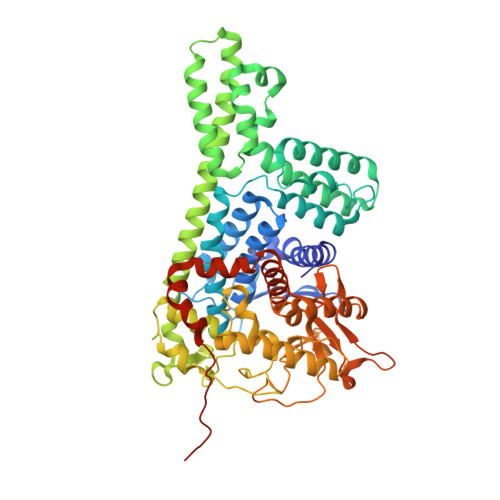Functional and structural analysis of a cyclization domain in a cyclic beta-1,2-glucan synthase.
Tanaka, N., Saito, R., Kobayashi, K., Nakai, H., Kamo, S., Kuramochi, K., Taguchi, H., Nakajima, M., Masaike, T.(2024) Appl Microbiol Biotechnol 108: 187-187
- PubMed: 38300345
- DOI: https://doi.org/10.1007/s00253-024-13013-9
- Primary Citation of Related Structures:
8WY1 - PubMed Abstract:
Cyclic β-1,2-glucan synthase (CGS) is a key enzyme in production of cyclic β-1,2-glucans (CβGs) which are involved in bacterial infection or symbiosis to host organisms. Nevertheless, a mechanism of cyclization, the final step in the CGS reaction, has not been fully understood. Here we performed functional and structural analyses of the cyclization domain of CGS alone from Thermoanaerobacter italicus (TiCGS Cy ). We first found that β-glucosidase-resistant compounds are produced by TiCGS Cy with linear β-1,2-glucans as substrates. The 1 H-NMR analysis revealed that these products are CβGs. Next, action pattern analyses using β-1,2-glucooligosaccharides revealed a unique reaction pattern: exclusive transglycosylation without hydrolysis and a hexasaccharide being the minimum length of the substrate. These analyses also showed that longer substrate β-1,2-glucooligosaccharides are preferred, being consistent with the fact that CGSs generally produce CβGs with degrees of polymerization of around 20. Finally, the overall structure of the cyclization domain of TiCGS Cy was found to be similar to those of β-1,2-glucanases in phylogenetically different groups. Meanwhile, the identified catalytic residues indicated clear differences in the reaction pathways between these enzymes. Overall, we propose a novel reaction mechanism of TiCGS Cy . Thus, the present group of CGSs defines a new glycoside hydrolase family, GH189. KEY POINTS: • It was clearly evidenced that cyclization domain alone produces cyclic β-1,2-glucans. • The domain exclusively catalyzes transglycosylation without hydrolysis. • The present catalytic domain defines as a new glycoside hydrolase family 189.
- Department of Applied Biological Science, Faculty of Science and Technology, Tokyo University of Science, 2641 Yamazaki, Noda, Chiba, 278-8510, Japan. n_tanaka@rs.tus.ac.jp.
Organizational Affiliation:
















